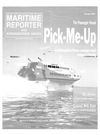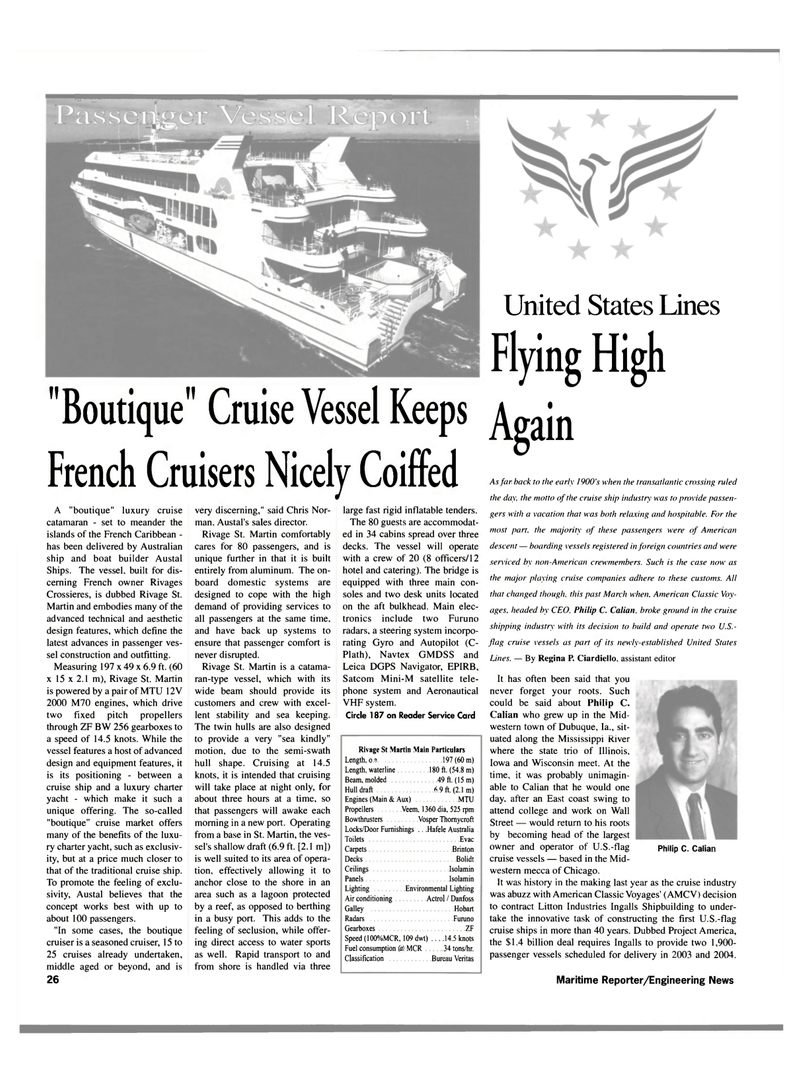
Page 26: of Maritime Reporter Magazine (January 2000)
Read this page in Pdf, Flash or Html5 edition of January 2000 Maritime Reporter Magazine
"Boutique" Cruise Vessel Keeps ^in ^ i ^ , . ^ . /v. « b
United States Lines
Flying High
French Cruisers Nicely Coiffed
A "boutique" luxury cruise catamaran - set to meander the islands of the French Caribbean - has been delivered by Australian ship and boat builder Austal
Ships. The vessel, built for dis- cerning French owner Rivages
Crossieres, is dubbed Rivage St.
Martin and embodies many of the advanced technical and aesthetic design features, which define the latest advances in passenger ves- sel construction and outfitting.
Measuring 197 x 49 x 6.9 ft. (60 x 15 x 2.1 m), Rivage St. Martin is powered by a pair of MTU 12 V 2000 M70 engines, which drive two fixed pitch propellers through ZF BW 256 gearboxes to a speed of 14.5 knots. While the vessel features a host of advanced design and equipment features, it is its positioning - between a cruise ship and a luxury charter yacht - which make it such a unique offering. The so-called "boutique" cruise market offers many of the benefits of the luxu- ry charter yacht, such as exclusiv- ity, but at a price much closer to that of the traditional cruise ship.
To promote the feeling of exclu- sivity, Austal believes that the concept works best with up to about 100 passengers. "In some cases, the boutique cruiser is a seasoned cruiser, 15 to 25 cruises already undertaken, middle aged or beyond, and is 26 very discerning," said Chris Nor- man. Austal's sales director.
Rivage St. Martin comfortably cares for 80 passengers, and is unique further in that it is built entirely from aluminum. The on- board domestic systems are designed to cope with the high demand of providing services to all passengers at the same time, and have back up systems to ensure that passenger comfort is never disrupted.
Rivage St. Martin is a catama- ran-type vessel, which with its wide beam should provide its customers and crew with excel- lent stability and sea keeping.
The twin hulls are also designed to provide a very "sea kindly" motion, due to the semi-swath hull shape. Cruising at 14.5 knots, it is intended that cruising will take place at night only, for about three hours at a time, so that passengers will awake each morning in a new port. Operating from a base in St. Martin, the ves- sel's shallow draft (6.9 ft. [2.1 m]) is well suited to its area of opera- tion, effectively allowing it to anchor close to the shore in an area such as a lagoon protected by a reef, as opposed to berthing in a busy port. This adds to the feeling of seclusion, while offer- ing direct access to water sports as well. Rapid transport to and from shore is handled via three large fast rigid inflatable tenders.
The 80 guests are accommodat- ed in 34 cabins spread over three decks. The vessel will operate with a crew of 20 (8 officers/12 hotel and catering). The bridge is equipped with three main con- soles and two desk units located on the aft bulkhead. Main elec- tronics include two Furuno radars, a steering system incorpo- rating Gyro and Autopilot (C-
Plath), Navtex GMDSS and
Leica DGPS Navigator, EPIRB.
Satcom Mini-M satellite tele- phone system and Aeronautical
VHF system.
Circle 187 on Reader Service Card
Rivage St Martin Main Particulars
Length, o.a 197 (60 m)
Length, waterline 180 ft. (54.8 m)
Beam, molded 49 ft. (15 m)
Hull draft 6.9 ft. (2.1 m)
Engines (Main & Aux) MTU
Propellers Veem, 1360 dia. 525 rpm
Bowthrusters Vosper Thomycroft
Locks/Door Furnishings .. .Hafele Australia
Toilets Evac
Carpets Brinton
Decks Bolidt
Ceilings Isolamin
Panels Isolami
Lighting Environmental Lighting
Air conditioning Actrol / Danfoss
Galley Hobart
Radars Furuno
Gearboxes ZF
Speed (100%MCR, 109 dwt) ... .14.5 knots
Fuel consumption (a MCR 34 tons/hr.
Classification Bureau Veritas
As far back to the early 1900's when the transatlantic crossing ruled the day, the motto of the cruise ship industry was to provide passen- gers with a vacation that was both relaxing and hospitable. For the most part, the majority of these passengers were of American descent — boarding vessels registered in foreign countries and were serviced by non-American crewmembers. Such is the case now as the major playing cruise companies adhere to these customs. All that changed though, this past March when, American Classic Voy- ages, headed by CEO, Philip C. Calian, broke ground in the cruise shipping industry with its decision to build and operate two U.S.- flag cruise vessels as part of its newly-established United States
Lines. — By Regina P. Ciardiello. assistant editor
It has often been said that you never forget your roots. Such could be said about Philip C.
Calian who grew up in the Mid- western town of Dubuque, la., sit- uated along the Mississippi River where the state trio of Illinois,
Iowa and Wisconsin meet. At the time, it was probably unimagin- able to Calian that he would one day, after an East coast swing to attend college and work on Wall
Street — would return to his roots by becoming head of the largest owner and operator of U.S.-flag cruise vessels — based in the Mid- western mecca of Chicago.
It was history in the making last year as the cruise industry was abuzz with American Classic Voyages' (AMCV) decision to contract Litton Industries Ingalls Shipbuilding to under- take the innovative task of constructing the first U.S.-flag cruise ships in more than 40 years. Dubbed Project America, the $1.4 billion deal requires Ingalls to provide two 1,900- passenger vessels scheduled for delivery in 2003 and 2004.
Maritime Reporter/Engineering News
Philip C. Calian

 25
25

 27
27
